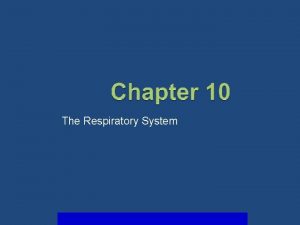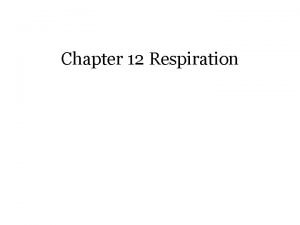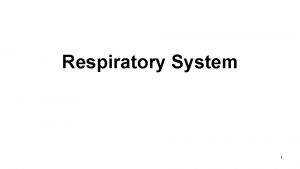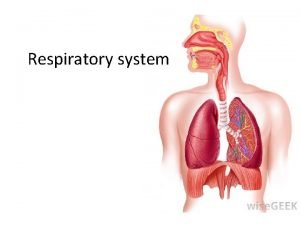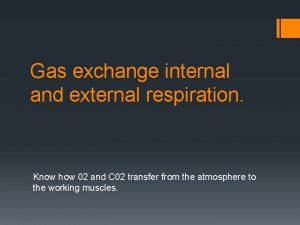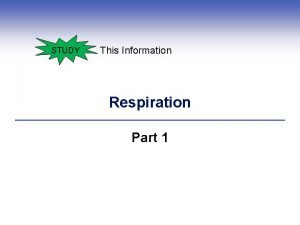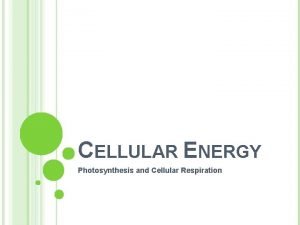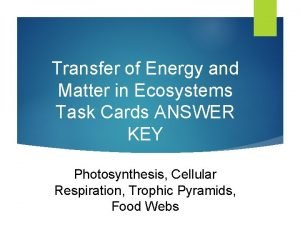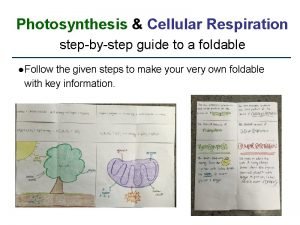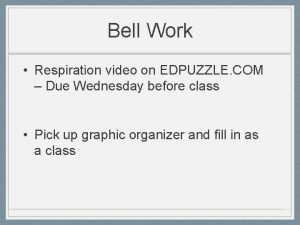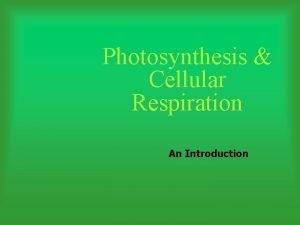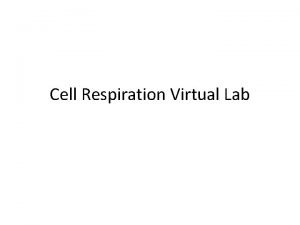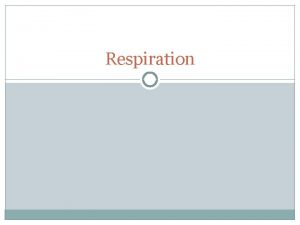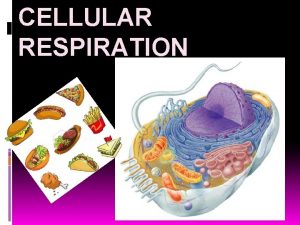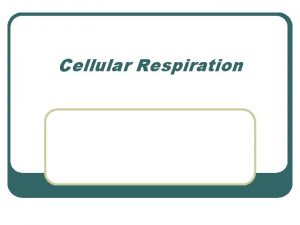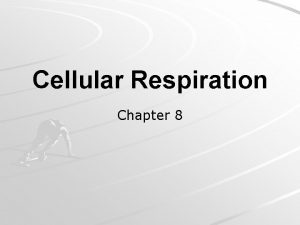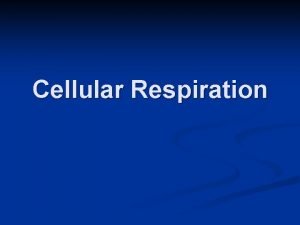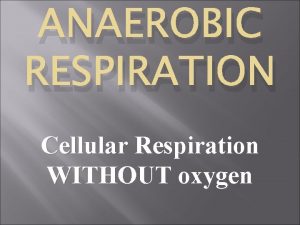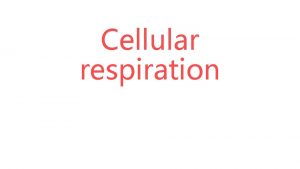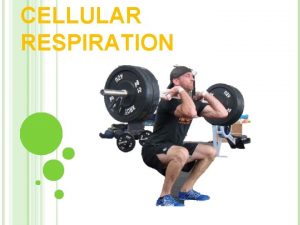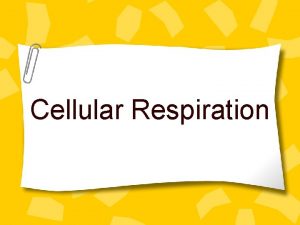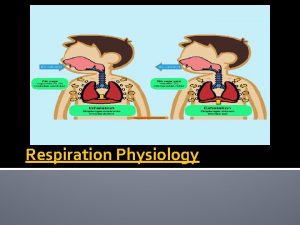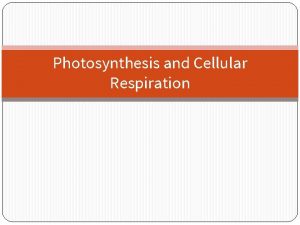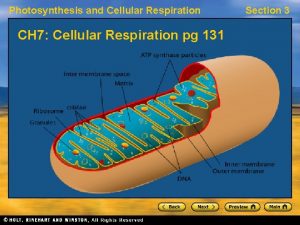RESPIRATION INTERNAL AND EXTERNAL INTERNAL RESPIRATION z CELLULAR

























- Slides: 25

RESPIRATION INTERNAL AND EXTERNAL

INTERNAL RESPIRATION z. CELLULAR METABOLISM z. ANAEROBIC GLYCOLYSIS z. AEROBIC OXIDATIVE METABOLISM IN THE MITOCHONDRIA

EXTERNAL RESPIRATION z. Ventilation or breathing: air moved in and out of lungs z. Oxygen and Carbon Dioxide exchange in the lungs z. Oxygen and Carbon Dioxide transported by blood to and from tissues z. Exchange of Oxygen and Carbon Dioxide between tissue and blood

EXTERNAL AND INTERNAL RESPIRATION ATMOSPHERE SYSTEMIC CIRCULATION HEART PULMONARY CIRULATION LUNGS TISSUE CELL O 2 + FOOD CO 2 + H 2 O + ATP

THE RESPIRATORY SYSTEM z. Nasal Passages z. Mouth z. Pharynx z. Larynx z. Trachea z. Bronchi z. Alveoli z. Lung

Alveoli z. Small, thin walled, inflatable sacs at end of bronchioles z. Surrounded by jacket of pulmonary capillaries z. Provide thin barrier and enormous surface area for gas exchange by diffusion z. Type II secrete surfactant

Alveoli and Pulmonary Capillaries

RESPIRATION The Mechanics of Breathing

PRESSURES AT REST z. Atmospheric pressure: 760 mm Hg z. Intra-alveolar pressure: 760 mm Hg z. Intrapleural pressure: 756 mm Hg

BAROMETRIC PRESSURE VACUUM 760 mm WEIGHT OF COLUMN OF AIR = FORCE/AREA = PRESSURE Sea Level Mercury Hg

REST PRESSURES Atmosphere Airways Pleural Sac 760 MM Hg Intrapleural pressure 756 mm. Hg Thoracic Wall Lungs

THE TRANSMURAL PRESSURE GRADIENT INFLATES THE LUNGS z. Thoracic cavity larger than lungs z. Transmural (Across Lung Wall) pressure gradient holds thoracic wall and lungs in close apposition z. This pressure gradient is balanced by the elastic forces in the alveoli producing equilibrium

REST PRESSURES Atmosphere Airways Pleural Sac 760 MM Hg Intrapleural pressure 756 mm. Hg Thoracic Wall Lungs

AIR IS A COMPRESSABLE GAS WHICH OBEYS BOYLE’S LAW z. P 1 V 1 = P 2 V 2 z. If Volume increases, Pressure must decrease z. As lungs expand, pressure inside falls

INSPIRATION z. Elevation of ribs expands lungs z. Lowering of diaphragm by contraction also expands lungs z. Expansion of lungs causes pressure inside to drop below atmospheric pressure z. Air rushes in to fill the expanded lungs

INSPIRATION Atmosphere Airways 760 mm Hg 759 mm Hg Pleural Sac Intrapleural pressure 754 mm. Hg Thoracic Wall Lungs

EXPIRATION z. Return of ribs to rest position causes diminishing of lung volume z. Return of diaphragm to rest position also causes diminishing of lung volume z. Diminishing of lung volume causes pressure in lung to raise to a higher value than atmospheric pressure z. Air flows out of the lungs

EXPIRATION Atmosphere 760 mm Hg Airways 761 mm Hg Pleural Sac Intrapleural pressure 756 mm. Hg Thoracic Wall Lungs

MUSCLES OF INSPIRATION z. Sternocleidomastoid z. Scalenus z. External Intercostals z. Diaphragm

MUSCLES OF EXPIRATION z. Internal intercostals z. Abdominals

AIRWAY RESISTANCE z. Flow of air depends on the pressure gradient (atmospheric, Pa, and intraalveolar, Pi) and the airway resistance, R z. F = (Pa - Pi)/R z. Resistance depends primarily on the radius of the conducting airways z. Parasympathetic stimulation constricts, while sympathetic dilates

Resistance and Disease z Colds z Asthma: Constriction of small airways, excess mucus, and histamine-induced edema z Bronchitis: Long term inflamitory response causing thickened walls and overproduction of mucous z Emphysema: Collapse of smaller airways and breakdown of alveolar walls z Alveolar surface tension

LUNG VOLUMES z. Tidal Volume (TV): 500 ml z. Inspiratory reserve volume (IRV): 3 liters z. Inspiratory capacity (IC): 3. 5 liters z. Expiratory reserve volume (ERV): 1 liter z. Residual volume (RV): 1. 2 liters z. Functional Residual Capacity (FRC): 2. 2 l z. Vital Capacity (VC): 4. 5 liters z. Total Lung Capacity (TLC): 5. 7 liters

LUNG VOLUMES

LUNG VOLUMES: RELATIONSHIPS z. IC = IRV + TV z. FRC = ERV + RV z. VC = IRV + TV + ERV z. TLC = VC + RV
 External respiration
External respiration Internal vs external respiration
Internal vs external respiration Learning objectives of respiratory system
Learning objectives of respiratory system Labled
Labled Meduula
Meduula Amloplast
Amloplast External vs internal respiration
External vs internal respiration Internal vs external respiration
Internal vs external respiration Bird respiratory system
Bird respiratory system Complementary processes
Complementary processes Photosythesis equation
Photosythesis equation Equation for cell respiration
Equation for cell respiration Cellular respiration equation
Cellular respiration equation Where does cellular respiration take place
Where does cellular respiration take place Photosynthesis and cellular respiration foldable
Photosynthesis and cellular respiration foldable Where does the oxygen that we breathe come from edpuzzle
Where does the oxygen that we breathe come from edpuzzle Photosynthesis and cellular respiration
Photosynthesis and cellular respiration Snails and elodea virtual lab
Snails and elodea virtual lab The mimosa plant displays thigmotropism
The mimosa plant displays thigmotropism Photosynthesis and cellular respiration jeopardy
Photosynthesis and cellular respiration jeopardy Cellular respiration redox
Cellular respiration redox What is the correct equation for cellular respiration?
What is the correct equation for cellular respiration? Chemiosmosis steps
Chemiosmosis steps Types of respiration
Types of respiration Lactic acid fermentation equation
Lactic acid fermentation equation Why is cellular respiration important
Why is cellular respiration important


